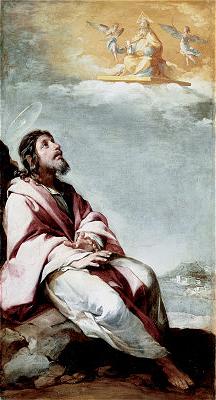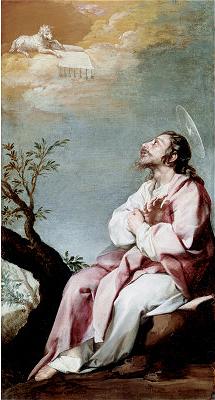Alonso Cano
Spanish, 1601-1667 ST JOHN THE EVANGELIST’S VISION OF GOD SN 344
ST JOHN THE EVANGELIST’S VISION OF THE LAMB SN 345
Both oils on canvas, c. 1638
From "The Pages".
ARTIST:
Cano was an artist of rare versatility in 17th c Spain. He was a painter & sculptor
also known for his drawings. While his architectural work was not extensive, his
reputation was sufficient for his advice to be sought on the building of the Ochavo chapel
in Toledo in 1650.
His father worked as an ensamblador (designer of altarpieces) who apprenticed Alonso to
Francesco Pacheco’s workshop in Seville just as Velásquez was |
|
 |
|
 |
completing his own training there, and the two artists became lifelong friends. Pacheco
emphasized the importance of drawing, so that Cano’s work was distinguished by its
purity of line, contour, and classical feeling. Cano’s artistic legacy is partly
measured by the painters and sculptors who later trained in his workshop and went on to
become important masters in their own right.
Cano’s personal life was turbulent. In 1626 he married Maria de Figueroa, who came
from a family of artists. She died two years later. In 1631 he married Maria Magdalena de
Uceda,
the 12-yr old daughter of another artist. (Marriage at such extreme youth can probably be
explained by the death of her father shortly thereafter; he must have wanted to assure her
future.) Things must not have gone well, however, for 5 years later Cano had to be bailed
out of debtor’s prison by a friend. In 1644, when Maria was 25, she was stabbed to
death in her bed. Alonso was finally acquitted of the murder - but not until after he was
tortured while under suspicion of having hired her assassin.
After some delays (he failed his Latin exam), Cano was ordained as a priest in 1658. Upon
his death in1667 he was buried in crypt of the Granada Cathedral.
SUBJECT:
Both of these paintings show St John’s visions as recounted in the Apocalypse.*
PAINTINGS:
In SN 344, John looks upward at a personification of God on His throne surrounded by
angels. In SN 345, John looks up at the Lamb of God. In both, John has a very visible
halo. Vestigial landscapes support each scene.
These paintings, executed between 1635 and 1638, were originally parts of a large,
multi-paneled altarpiece in the convent church of St Paula in Seville. It was the only
Cano altarpiece which survived intact, until the paintings were dispersed in 1810.
They portray large-scale figures set close to the picture plane, which would have been
clearly legible within their original complex framework. Cano’s elegance of line and
clear, pale colors bear more resemblance to the paintings of contemporary Bolognese
classicizing artists than to the dark, sculptural images still being produced by his
contemporaries in Seville. Cano has used such high key colors and bright lighting to
accentuate the visionary nature of the subject matter.
* In 1820 some 12-14 books comprising the Apocalypse were dropped from the King James
version. They included books of history, philosophy, tales, and poetry.
Museum Labels
Saint John the Evangelist's Vision of God
1638
Artist: Alonso Cano
Spanish, 1601-1667, active in Granada, Seville, and Madrid
Oil on canvas, 28 1/2 x 15 3/4 in. (72.4 x 40 cm)
This painting and Saint John the Evangelist's Vision of the Lamb (also displayed in this
gallery), showing scenes of Saint John's visions as recounted in the Book of Revelation,
were originally part of a large multi-paneled altarpiece in the convent church of Saint
Paul in Seville. Other paintings from this now dismantled altarpiece are now in the
Louvre, Paris, and the Wallace Collection, London. Cano introduces highly keyed,
theatrical colors and bright lighting to accentuate the visionary nature of the subject
matter.
Bequest of John Ringling, 1936, SN344 |
|
Saint John the Evangelist's Vision of the Lamb
1638
Artist: Alonso Cano
Spanish, 1601-1667, active in Granada, Seville, and Madrid
Oil on canvas, 28 3/4 x 15 3/4 in. (73 x 40 cm)
Alonso Cano was a pupil of Francisco Pacheco in Seville, where he became a lifelong friend
of fellow student Velázquez. Cano's life was marked by turmoil. His wife was murdered in
1644. Although Cano had been suspected of hiring the assassins, he was ultimately
acquitted. In addition to his work as a painter, Cano was also active as an architect and
sculptor. His design for the façade of the Cathedral in Granada is his most notable work
as an architect.
Bequest of John Ringling, 1936, SN345 |
ringlingdocents.org
|

